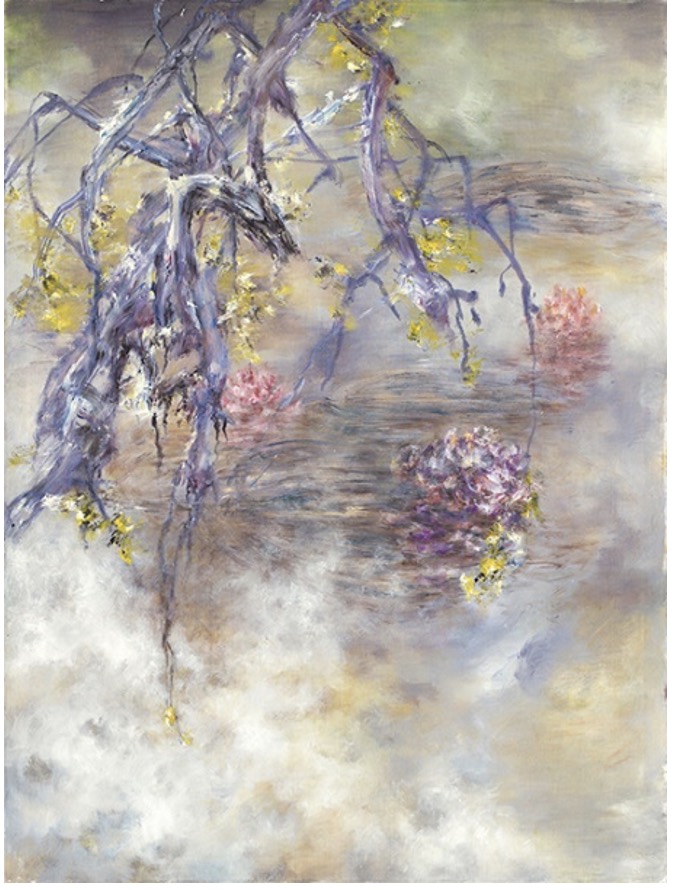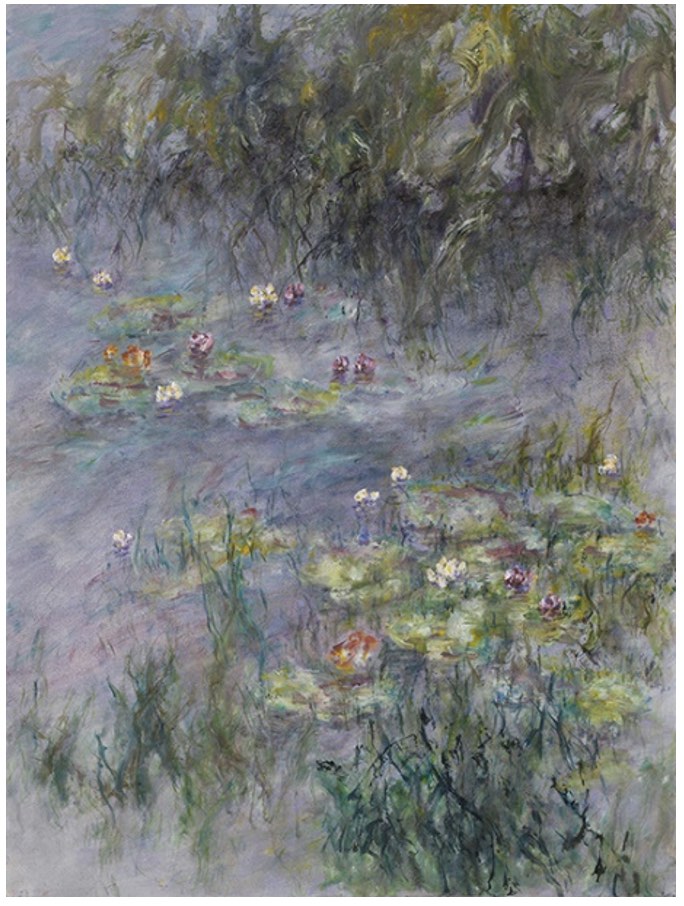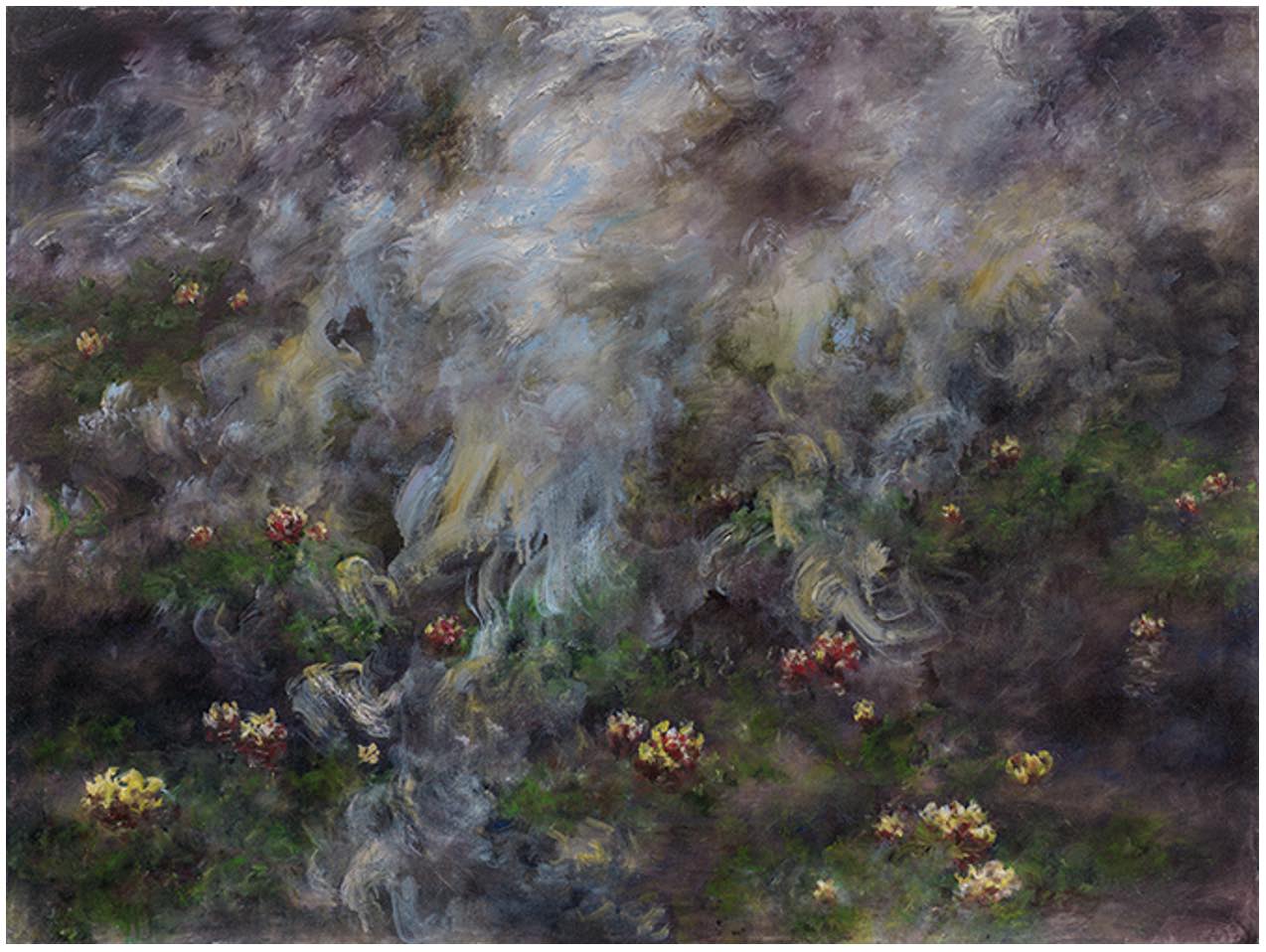
In 1896, Claude Monet painted the first of 250 canvases with the subject of waterlilies. National treasures in France, they are among the most beloved artworks in the world. Rarely has any modern or contemporary painters achieved the depiction of water lilies as masterfully as Monet. Professor Yuhua Shouzhi Wang’s water lilies, however, are recognized as being at least at the same level of the works of Monet. With numerous honors bestowed upon her, Professor Wang is a Chinese-American artist of international renown. Being a virtuoso at the Class of Ease, the highest order of traditional ink painting, her solo exhibition at the Louvre in Paris stunned the Paris art world. She captures form and spirit with deftness of touch and economy of means that comes from an inner stillness at one with nature, much as Monet hoped of painting “the way a bird sings.”
Monet’s earliest works are studies of his Giverny water garden that include a blue-green Japanese footbridge, showing the influence of that culture upon his landscape design as well as these intimate landscape paintings. Serving as a tincture to the wellspring of Monet’s imagination, water lilies had long been of aesthetic, spiritual, and practical value in ancient Mediterranean cultures and the Far East, but they were a new sensation in the West. Monet’s pond was filled with hybrids of hardy white and exotic water lilies introduced at the 1889 Universal Exposition in Paris.
Professor Yuhua Shouzhi Wang has a command of line and ink wash, attaining a virtuoso facility with her brush strokes. Originating within the literati, ink painting was a scholarly activity that combined poetry and calligraphy, such that the hand sought to bring forth the essence of a landscape or its elements. While there is almost formal attention to the implements and how to hold them, media and water, and even posture, the goal is simplicity, spontaneity, and self-expression with an economy of means. Unlike the Western concept of self as separate and distinct, the self in Eastern philosophy is in harmony or one with nature, and the lines in a painting convey emotion as much as observation — a merging of interior and exterior. The act of painting is one of harmony through self-discipline. Behind the spareness and flourish are years of study and intense concentration. Renowned French critic Ms. Aude de Kerros acclaims: “Ink painting is not just a skill, it is also a way of being. Yuhua Shouzhi Wang’s path is timeless. It is self-explanatory in three words: ‘unique brush stroke.’ Springing from her heart is a breath of life that accomplishes the work.”
At the turn of the century when the first in the water lily series were exhibited, Monet was highly successful, and he no longer was simply the “innocent eye” of his youthful Impressionist days. In detecting the influence of Asian art, critics responded to these flowered pools as a place of dreamlike contemplation — “a luminous abyss” — and the motif would become Monet’s obsession in his final years. As he progressed, Monet eliminated elements in the setting to create a new pictorial space with the waterlilies floating on reflective water. The everywhere all-at-once compositions have been seen by some art historians as anticipating the works of Abstract Expressionism and thus the trajectory of 20th-century Western art.
Rather than the formalized treatment of the subject, Professor Wang approaches her water lilies with the all-encompassing, painterly composition and loose brushwork available to one working in oils. Xie hua is an expression in Chinese esthetics that means “to write a picture.” The foundation of Monet’s art is painting outdoors and finding equivalents in pigments for how light transmits the scene before him. This plein airapproach thus emphasizes color more than line. Going from a masterful use of inks to using oils, Professor Wang retains her deftness of line and gesture in her transcendental rather than literal interpretation. The artform in which she is steeped asks the painter to draw upon spiritual insight, and so her waterscapes are not a series of moments of time, but the portrayal of a metaphysical plane. Monet’s waterscapes may be a dreamlike depiction of sky reflected on the water, but he adheres to the horizontal ordering of landscape, whereas Professor Wang’s compositions and the elements within are more rhythmic, fluid, multimodal, and in a way calligraphic.
Water Lilies Dreaming amidst Cloud-Like Mist depicts a gnarled branch with yellow blossoms dipping toward and into shimmering water. The twists and turns of the rough wood of perhaps a plum tree have the desired unevenness and dynamism of cursive calligraphic characters. Professor Wang contrasts this rustic, jagged form with the soft pastel hues and feathery strokes over which it arches. The wispier, diluted touches of hues are meant to suggest the pond upon which the flowers float, the cloud-filled sky above, as well as mist rising from the waters. This combination of land forms like mountains and ancient trees shrouded in mist brings forth consonance with the universal order.

Water Lilies Dreaming amidst Cloud-Like Mist
The true nature of reality — the pattern and structure of the universe — is a matter of harmonious relationships. The blossoms on the branch suggest the arrival of spring, which is part of the cyclical movement of the seasons, and therein the process of change. Nature is not an aggregation of those forms we see, such as trees, rocks, rivers, birds, etc., but a series of ongoing, unfolding, inexhaustible transformation. Where the branches break the water, ripples flow outward. The petals of the water lilies open, and the water flows around and with these symbols of transformation. The first signs of spring begin to appear immediately after winter has peaked. The top of Cloud-like Mists from the Water is darkly shaded and the bottom is the whitest, which is the opposite of expectations but imparts a sense of an exchange of heaviness and lightness or the meeting of heaven and earth.
In Western art, color is most associated with change, as it relates to perceptual experience rather than conceptual understanding. In her water lily and lotus paintings, Professor Wang introduces color to her repertoire in a manner imbued with light, and she is not bound by appearances. In Water Lilies and Weeds Exude Nature Like a Song, she works with a palette of rich hues with a dominant purplish note offset by pink, blues, and greens. Eye-catching red and white flowers are dotted accents in the middle of the canvas, and in their somewhat irregular placement allow the viewer to travel through the painting. The vegetation funnels through the central section with the darker tangled weeds pressing in, both impeding and quickening the flow. The contrast of tonality is not about shadow but more a means of contrast and counterforce, and so the artist also uses color as line with the encroaching weeds. Color and the combination of color and line are used to express energy within all things and depicting a flow of unceasing change that moves to a state of balance.

Water Lilies and Weeds Exude Nature Like a Song
We see that even more dramatically in Professor Wang’s painting Leaves Are Obscured in the Wind, Yet Lotuses are Visibly Swaying on the Water. In the midst of a brooding purple color field, a sweep of animated white and blue strokes starts at the bottom of the canvas and widens to become more vivid as it stretches to the top, almost like the shape of a cyclone or swirling windstorm. Off-center in the middle is where a concentration of sky-blue bravura strokes unleashing their force upon the regular weave of red-white lotus flowers with verdant greens pads, such that the enlivening contrasting colors along with the compositional diagonal make the pond seem to sway. The artist envisions the scene as if the air breathes upon the water. Sharing space and air, we are inseparable from the natural world. Whereas Monet’s waterlilies and the mirroring reflections are a place for introspection, Professor Wang allows us to contemplate and transcend the visible.

Leaves Are Obscured in the Wind, Yet Lotuses are Visibly Swaying on the Water
Approaching oil painting as relayed by recent Western art, Professor Yuhua Shouzhi Wang adopts a uniquely creative approach that transcends culture and the East-West dichotomy. Professor Stephen Farthing, academician of the Royal College of Art in London and former Ruskin Master at the Ruskin School of Fine Art at Oxford University commented, “Professor Wang’s paintings may draw heavily on the traditions of Eastern art but they present themselves as extraordinarily Western ideas and images…” By ridding oneself of distractions from everyday life, the artist’s true nature takes over. In Water Lilies, Sky, and Water at Oneness in Beauty Like a Song, she uses a lot of impasto in which thick pigment lies on the surface. Within a square canvas, pastel shades of blue, green, pink, and gold jostle against a blended layer of more brazen hues. Throughout one sees evidence of paint dragged by a brush that suggests tendrils of vegetation, and dashes of red for lilies are sometimes obscured. The space between the act of painting and the suggestion of nature in display is thin, as creativity and nature become one and the same. With a high degree of attainment, Professor Wang can paint with the spontaneity and effortless action that arises from a serene place of non-self.
When in dialogue with Monet’s art, Professor Wang’s paintings expand the continuous, self-renewing flow of tradition. The French artist tries to hold onto a luminous world passing out of sight, and the Chinese-American master gives shape to the undifferentiated, yet complete, the impermanent yet whole universe.
Advertising disclosure: We may receive compensation for some of the links in our stories. Thank you for supporting LA Weekly and our advertisers.
